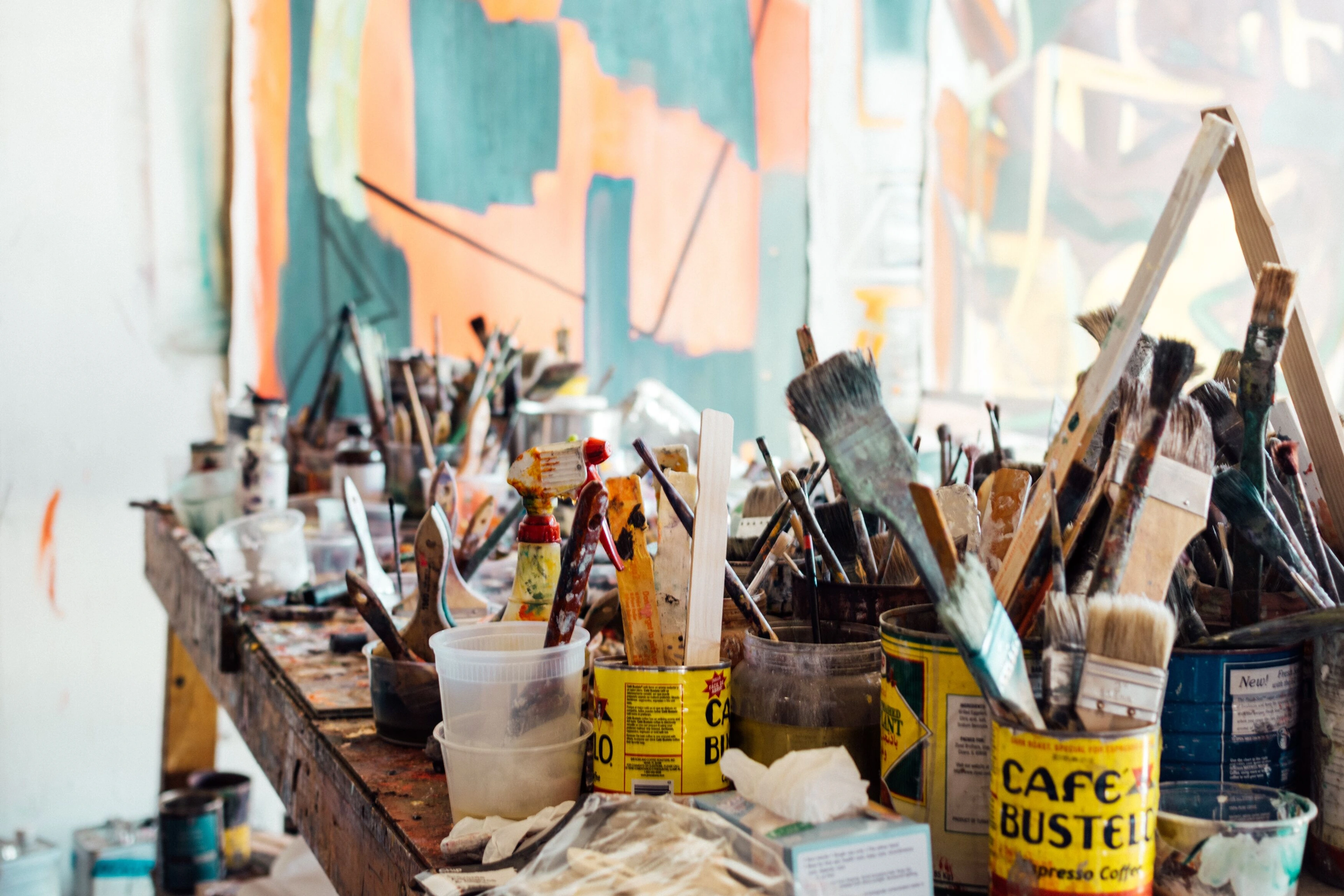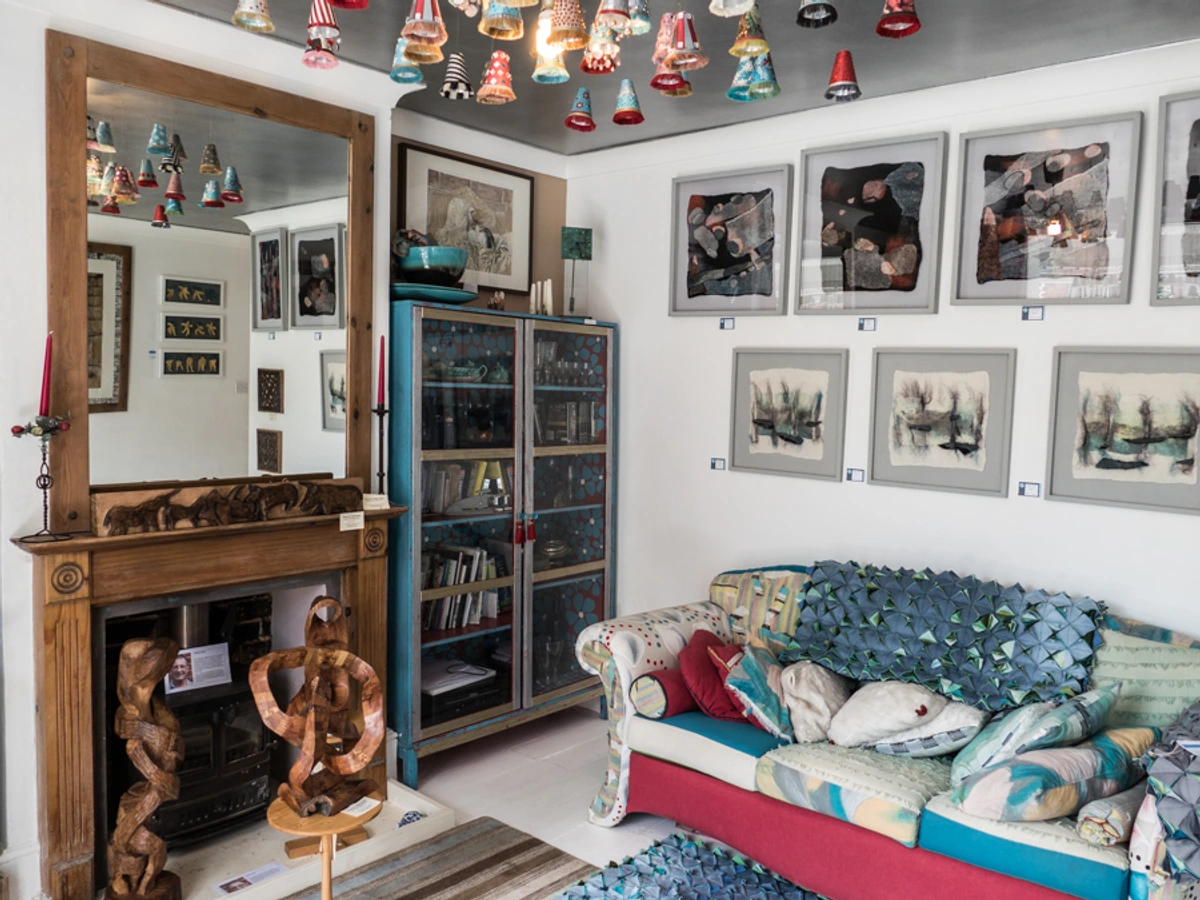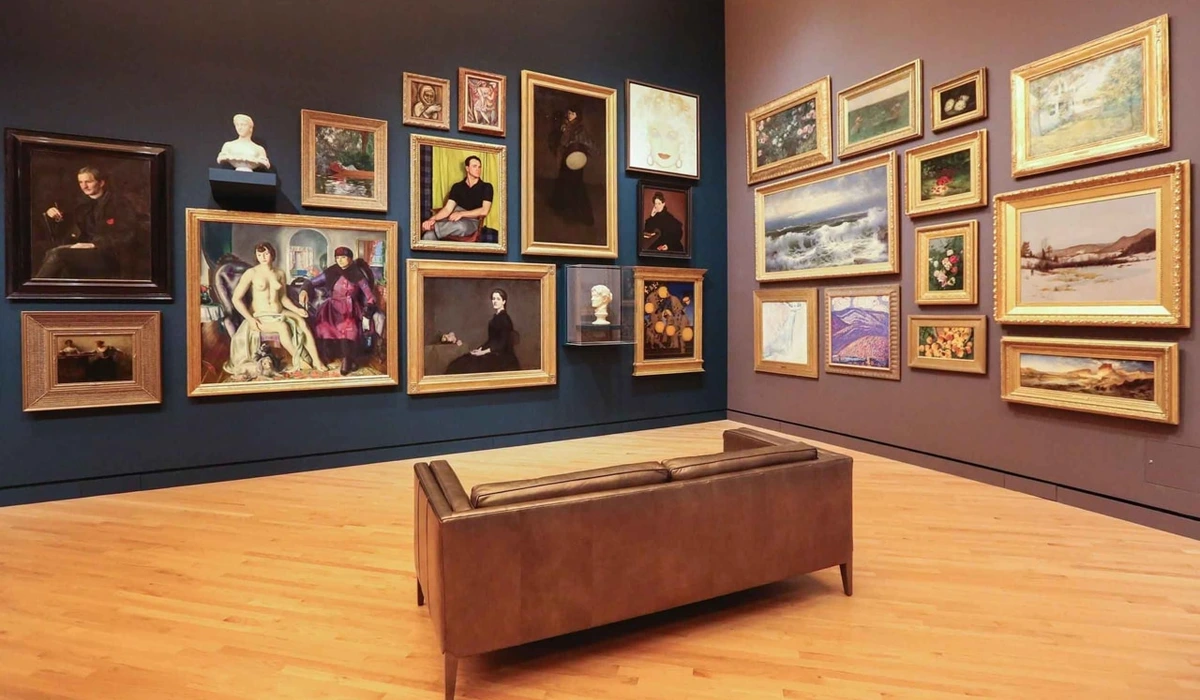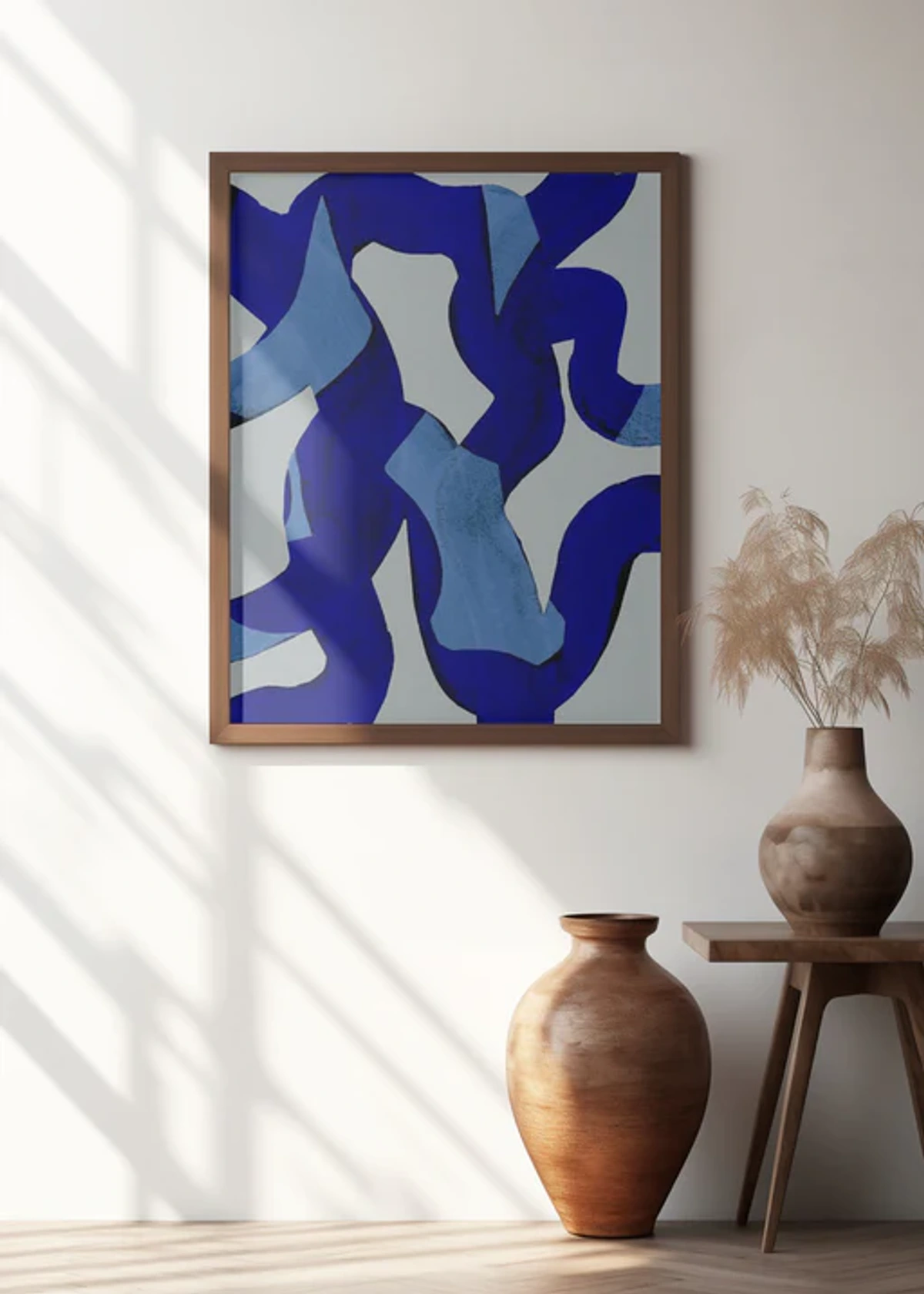
Contemporary Art for Home: An Artist's Ultimate Guide to Choosing & Displaying
Transform your home with contemporary art! This ultimate guide from an artist covers finding your style, choosing pieces (including prints & mixed media), display tips, and personal insights to make your space uniquely yours.
Bringing Your Walls to Life: The Ultimate Guide to Contemporary Art for Home
Let's be honest, staring at blank walls gets old. Your home is your sanctuary, your personal bubble, the place where you can finally take off those slightly-too-tight jeans. Shouldn't it reflect you? Adding art is one of the most powerful ways to inject personality, spark conversation, and make a space truly feel like your own. I remember the first time I hung a piece I'd bought, not made – a small, vibrant abstract print. It wasn't a grand gesture, but seeing it there, a splash of someone else's creative energy on my wall, felt like a little rebellion against beige, a quiet declaration of who I was becoming. And when it comes to making a statement, contemporary art offers a universe of possibilities.
But wait, "contemporary art"? Doesn't that mean confusing squiggles, overpriced canvases, or things that look suspiciously like my toddler nephew could have made them during a tantrum? Sometimes, maybe. (I've definitely had studio days that felt like a tantrum, though hopefully with slightly more intentional results.) But mostly, no. It's a vast, exciting world, and finding the right piece for your home is more achievable (and fun!) than you might think.
This guide is designed to be your friendly, slightly chatty companion on this journey. We'll demystify contemporary art, explore how to find pieces that resonate with you (without needing an art history degree), and figure out how to make them look amazing in your space. Ready to ditch the beige and embrace the bold? Let's dive in.
So, What Exactly Is Contemporary Art for the Home?
Okay, let's clear this up first. Contemporary art, simply put, is art being made now, or in the relatively recent past (think late 20th century onwards). It's the art of our time, created by artists living and working today, responding to the world around us. Beyond the definition, contemporary art often carries a sense of immediacy, a reflection of current thoughts, feelings, and societal shifts. It can feel raw, experimental, or deeply personal, offering a direct connection to the artist's present moment. Think of something like a bold, large-scale abstract painting that captures the energy of a city, or a mixed-media piece incorporating found objects that tell a story about modern life.
It often gets confused with Modern Art, which generally refers to art from the late 19th century up to around the 1970s (think Picasso, Matisse, Van Gogh – giants, yes, but from a different era). Think of it like music genres – Modern Art is classic rock, while Contemporary Art is everything being produced today, from indie pop to experimental electronic. You can delve deeper into the history of art periods if you're curious.
The beauty of contemporary art for your home is its sheer diversity. It's not one single style. It encompasses:
- Abstract Art: Exploring color, form, and texture without representing reality directly. Think bold color fields, energetic gestures, or intricate patterns. (Why is abstract art compelling, you ask? We have thoughts on that.)
- Figurative Art: Representing people, places, or things, but often with a fresh, modern perspective or technique.
- Minimalism: Stripped-down forms, clean lines, focusing on essential elements.
- Pop Art: Drawing inspiration from popular culture, advertising, and mass media.
- Street Art/Graffiti Art: Bringing urban energy and social commentary indoors.
- Photography: Capturing moments, perspectives, and stories through a lens.
- Sculpture & Mixed Media: Adding three-dimensional interest and texture.
- Digital Art: Art created using digital tools, often existing purely in digital form or as prints.
- Installation Art: While large-scale installations are museum pieces, smaller, home-friendly installations or sculptural arrangements can add unique depth.

Contemporary art in your home isn't about following trends dictated by fancy galleries (though knowing the best galleries in the world can be inspiring). It's about finding pieces that speak to you, reflect your taste, and enhance your daily life.
Why Bother? The Joy of Living with Contemporary Art
Okay, so it's diverse. But why choose contemporary art over, say, a nice landscape print from the homewares store? For me, it's about more than just filling a space. It's about inviting something more into my home.
- Personality Injection: It's a shortcut to showing who you are. Are you bold and vibrant? Calm and contemplative? Quirky and humorous? Contemporary art can reflect that. I have a small, slightly absurd sculpture in my studio that always makes me smile – it feels like a little piece of my own internal landscape made real.
- Conversation Starter: A unique piece inevitably draws the eye and sparks questions. "What is that?" can lead to surprisingly interesting chats (or just confused silence, which can also be funny). I've had pieces prompt discussions about everything from politics to the meaning of color.
- Emotional Connection & Mood: Art can evoke feelings, trigger memories, or simply make you smile when you walk past it. Finding a piece you genuinely love is like finding a new friend who just hangs out on your wall. There's a painting in my living room that just feels like home to me now. Beyond personal connection, art can dramatically shift the mood or energy of a room. A vibrant abstract piece can energize a space, while a serene landscape might bring calm. Think about the feeling you want the room to have, and let the art help create it.
- Supporting Living Artists: When you buy contemporary art, especially from emerging or mid-career artists, you're directly supporting someone's creative passion and livelihood. That feels pretty good. (Sometimes, you might even find unique pieces available online directly from artists or curated platforms.) It's a tangible way to participate in the creative ecosystem.
- It Doesn't Have to Be "Serious": Contemporary art can be playful, witty, beautiful, or thought-provoking. It doesn't always require deep analysis; sometimes, it's just about appreciating the aesthetics or the skill involved. I have pieces that are purely for visual joy, and others that make me pause and think.
- Challenges Your Perspective: Good contemporary art can push you outside your comfort zone. It might present a new way of seeing the world, question assumptions, or simply make you look closer. It's not just decoration; it's an invitation to engage.
Think of it like choosing music for your home – you pick what resonates, sets the mood, and makes you feel good. Art does the same, just visually.
Navigating the Maze: Finding Your Contemporary Art Style
"Okay, I'm intrigued, but where do I even start? I don't know what I like!" This is perfectly normal. Discovering your art taste is a journey, not a destination. I remember feeling completely overwhelmed when I first started looking beyond my own work – like walking into a massive library with no Dewey Decimal system. Here's how to begin exploring:
- Browse, Browse, Browse (Without Pressure): Look online (Pinterest, Instagram, gallery websites, museum collections like those found in the best museums for modern art), visit local galleries (even just to window shop – find the best galleries in your city), or even check out art sections in magazines. Don't try to judge yet, just notice what catches your eye. As an artist, I spend hours just looking at other people's work online and in person. It's like visual research, but mostly it's just feeding my soul (and sometimes making me question everything I'm doing).
- Identify Patterns: After a while, you might notice you're drawn to certain colors, styles (Abstract? Figurative? Minimalist?), or subjects. Are you loving bold colors? Geometric shapes? Moody photographs? Consider creating a physical or digital mood board (Pinterest is great for this) to visually track what you like. I often find myself drawn to certain color palettes or textures, even across different artists.
- Consider Your Space: Think about the room where you envision the art. What's the existing color scheme? The mood? The furniture style? You don't need to match perfectly (contrast can be great!), but awareness helps. Our guides on decorating specific rooms like the living room, bedroom, or even the office might offer inspiration.
- Trust Your Gut: Forget what you think you should like. If a piece makes you feel something – happy, curious, calm, energized – pay attention. That connection is what matters most. Defining your personal art style and taste is an ongoing process.
- Start Small: You don't need to buy a massive statement piece right away. A smaller print or photograph can be a great way to test the waters.
This exploration phase is key. It's less about finding the piece and more about understanding your own visual language. It's like learning a new dialect, but instead of words, it's shapes, colors, and textures. And sometimes, you'll stumble upon something completely unexpected that just clicks. That's the magic.

Choosing the Right Piece: Practical Magic
So, you've done the browsing, you've got a sense of your style. Now comes the exciting (and sometimes slightly nerve-wracking) part: picking the piece that will live with you. Here's how to approach it:
- Size & Scale: This is crucial, and it's not just about the wall space. Consider the overall room size and ceiling height. A huge piece in a small room can feel overwhelming, while a tiny piece on a vast wall gets lost. Measure your space! Think about the viewing distance – will you be up close or across the room? Sometimes, grouping smaller pieces works better than one large one. From my perspective in the studio, I'm always thinking about how a piece will interact with a space, not just a flat wall. It's about volume and presence. Check our guide on how to decorate a wall for ideas.
- Color Palette: Does the art complement or contrast with your room's colors? Both can work! A neutral room might crave a pop of color, while a colorful room might benefit from a more subdued piece. Consider how the colors in the art make you feel in that specific room.
- Medium: The material and form of the art impact its presence.
- Paintings (Originals): Unique, textured, often a significant investment. Understanding how much original art costs is key. The brushstrokes, the layers of paint – they tell a story of the artist's hand.
- Prints (Limited Edition or Open): More affordable, allows access to popular artists or specific images. A great starting point. Limited edition prints are produced in a fixed number, signed and numbered by the artist, which can increase their value and collectibility over time. Open edition prints have no limit on the number produced and are generally less expensive, making them a fantastic option for decorative purposes. See our guide on buying art prints. Wondering about prints versus paintings? We've got you covered.
- Photography: Offers diverse styles, from landscapes to portraits to abstracts. The choice of paper and printing method can dramatically change the feel.
- Sculpture: Adds a 3D element, interacts with light and space differently. Can be floor-standing, tabletop, or even wall-mounted.
- Digital Art: Can range from digital paintings to generative art, often available as high-quality prints. Its clean lines and vibrant colors can feel very contemporary.
- Mixed Media & Assemblage: Combines different materials (paint, collage, found objects), adding layers of texture and meaning. These pieces often have a unique narrative built into their very construction. As an artist who sometimes works this way, I see the materials themselves as part of the story – a piece of old newspaper might reference history, a found object might evoke a specific memory or place. It's like a visual puzzle with layers of meaning.
- Small-Scale Installation/Assemblage: Think wall-mounted objects, small sculptural arrangements, or pieces that interact with the space around them in unexpected ways. These can be incredibly engaging.
- Budget: Be realistic. Contemporary art exists at all price points. You can find amazing affordable original art online or great prints for less. Explore tips for starting an art collection on a budget or how to buy art for less. Keep an eye out for artist studio sales, end-of-year promotions, or online marketplace deals – sometimes you can find fantastic pieces at more accessible prices. Don't forget potential framing costs – our framing guide can help (more on framing styles below and in the FAQ).
- The "Love" Factor & The Story: Ultimately, ask yourself: Do I love looking at this? Will it bring me joy? If the answer is yes, you're on the right track. Also, consider the story behind the piece or the artist. Does the narrative resonate with you? Understanding the artist's intention or the journey of the artwork can deepen your connection to it. Before you commit, especially to a bigger purchase, review these 10 questions to ask before buying your first piece of art.
Choosing art is a personal dialogue. It's you, the artwork, and the space having a conversation. Listen carefully.

Where the Wild Art Is: Finding Contemporary Pieces
Ready to hunt? Here are prime locations:
- Online Galleries & Marketplaces: Huge selection, filter by style/price, convenient browsing. Platforms like Saatchi Art, Artsy, or even artist-focused sites offer vast choices. Our guide to buying art online safely is essential reading. We also have tips on where to buy art online generally.
- Artist Websites & Social Media: Buy directly from artists you discover and love. Many artists (like, ahem, the one behind this website - see the
art for salesection) sell directly. Following artists on platforms like Instagram is great for discovery. Don't be shy about reaching out to an artist directly if you have questions about a piece or their process – it's a great way to build a personal connection. - Art Fairs: See a lot of art under one roof, discover new talent. Can be overwhelming but exciting! Get tips for visiting art fairs as a buyer.
- Student Shows & Open Studios: Find affordable work from emerging artists – potentially the stars of tomorrow! Check local art schools or university art departments for their exhibition schedules. Sometimes even established artists open their studios, perhaps near interesting locations like 's-Hertogenbosch.
- Print Shops & Poster Stores: Affordable entry point, often featuring contemporary graphic design or reproductions.
Making It Work: Integrating Art into Your Home Decor
You found the perfect piece! Now what? Displaying it effectively makes all the difference. As someone who spends a lot of time making things to be hung on walls, I can tell you that the final placement is almost as important as the creation itself. It's where the art truly comes alive in your space.
- Placement is Key:
- Focal Point: Let a significant piece command attention above a sofa, fireplace, or bed.
- Eye Level: Generally, the center of the artwork should be at average eye level (around 57-60 inches or 145-152 cm from the floor). Adjust for furniture or ceiling height. Remember that point about scale and the whole room? This is where it comes in. A piece might look great on a wall, but does it feel right in the context of the entire space?
- Consider Sightlines: Where will you see the art most often? Place it where it can be appreciated.
- Unexpected Spots: Don't neglect hallways, bathrooms (ideas here), or kitchens (ideas here)! A small, surprising piece in a less obvious spot can be a delightful discovery.
- Consider the Light: Pay attention to how natural and artificial light hits the artwork at different times of day. A textured piece might catch the morning sun beautifully, while a photograph might be best in a spot with less direct light to avoid glare.

- Hanging Techniques:
- Single Statement: Let one strong piece shine.
- Gallery Wall: Mix and match sizes, orientations, and even frame styles for an eclectic look. Requires planning! A good tip is to start with a central piece and build outwards, or cut out paper templates the size of your frames and arrange them on the floor or wall first to visualize the layout. Our guide on how to decorate a wall has more ideas.
- Diptych/Triptych: Two or three related pieces hung together.
- Leaning: Casually lean larger pieces against a wall for a relaxed vibe (best in low-traffic areas). Just make sure it's stable! I once had a piece lean a little too casually... thankfully, it was just a print.
- Lighting Matters: Good lighting brings art to life. Avoid direct sunlight (can cause fading). Consider track lighting or picture lights.
- Relate to Furniture: Anchor art by relating it to furniture below it (e.g., center it over a console table).
- Framing Styles: For contemporary art, popular framing choices include simple box frames (where the art sits flush with the frame edge) or float frames (where the canvas appears to float within the frame, leaving a small gap). These styles tend to complement the clean lines and focus of much contemporary work. More details on framing different mediums are in the FAQ and our framing guide.
- Don't Be Afraid to Experiment: Move things around! Live with it for a bit. Sometimes the first spot isn't the best spot. Our guide on how to display different types of art covers paintings, sculptures, and more.
A Quick Word on Care
You've invested time, money, and emotion. Protect your art! Think of it like caring for a beloved plant – it needs the right environment to thrive.
- Keep out of direct sunlight.
- Avoid extreme temperature or humidity changes.
- Dust gently with a soft, dry cloth (or feather duster).
- Never use cleaning chemicals on paintings or prints.
- Handle canvases by the edges.
- Keep important documentation like receipts and Certificates of Authenticity (COA), especially for original pieces. This is crucial for provenance, potential future resale, or insurance purposes. Provenance, the history of ownership, is like the artwork's biography – it adds to its story and value.
For more detailed advice, check our guide on how to take care of your art.
Frequently Asked Questions (FAQ)
- Q: Is contemporary art a good investment?
- A: It can be, but it's not guaranteed. Buy art because you love it first and foremost. Investment potential is a possible bonus. Learn more about art as an investment and understanding art prices. Researching the artist's journey and career trajectory (like my own timeline, perhaps?) can offer clues, but predicting the market is tricky.
- Q: How much should I spend on contemporary art for my home?
- A: Spend what you're comfortable with! There's fantastic art available from under $100 (prints, emerging artists) to many thousands and beyond. Set a budget before you start looking seriously.
- Q: Can I mix contemporary art with traditional decor?
- A: Absolutely! The contrast can be incredibly stylish. A bold abstract piece can modernize a traditional room, and vice versa. It's all about balance and finding connections (like color or theme).
- Q: What if I buy something and then change my mind?
- A: It happens! Tastes evolve. If it's a print, it's less of a commitment. If it's an original, you might consider reselling it (see navigating the secondary market), gifting it, or moving it to a different room. Don't let fear of making the "wrong" choice paralyze you.
- Q: Do I need to frame contemporary art?
- A: Canvases are often displayed unframed (gallery wrap) for a modern look. Works on paper (prints, photos, drawings) generally need framing for protection. The style of frame can significantly impact the look – consider simple box frames or float frames for a contemporary feel. See our framing guide for more details on framing different mediums.
- Q: Can I commission a piece of art?
- A: Yes, absolutely! Commissioning art is a wonderful way to get a piece that is perfectly tailored to your space and vision. The process typically involves discussing your ideas, preferred style, size, and budget with the artist. They might create sketches or mock-ups for your approval before starting the final piece. It's a collaborative journey! Our guide on commissioning art goes into more detail.
- Q: Why does authenticity and provenance matter?
- A: Authenticity confirms the artwork is genuinely by the artist it's attributed to. Provenance is the history of ownership. Both are crucial for establishing the value and legitimacy of a piece, especially originals. They provide confidence in your purchase and are essential if you ever decide to sell or need to insure the artwork.
- Q: Should I insure my art?
- A: For pieces of significant value, yes, absolutely. Your homeowner's or renter's insurance might cover some art, but often there are limits. A separate fine art policy can provide more comprehensive coverage against damage, theft, or loss. It's worth discussing with your insurance provider once your collection grows or includes valuable pieces.
- Q: What's the difference between a limited edition and an open edition print?
- A: A limited edition print is produced in a fixed, predetermined quantity, often signed and numbered by the artist. Once that number is reached, no more are made, which can increase its value. An open edition print has no limit on the number produced and is generally more affordable, making it a great option for decorative purposes.
Your Home, Your Gallery
Bringing contemporary art into your home is about more than just decorating; it's about creating a space that feels alive, personal, and inspiring. It's a reflection of your unique perspective on the world.
Don't be intimidated by the jargon or the perceived exclusivity of the art world. Focus on discovery, trust your instincts, and choose pieces that genuinely resonate with you. Whether it's a small print that makes you smile or a large canvas that takes your breath away, the right contemporary art can transform your house into a home you truly love.
So go ahead, explore, be bold, and let your walls tell your story. It's less scary – and way more rewarding – than you might think. Maybe even less effort than trying to understand why I felt compelled to paint Minecraft that one time. Or perhaps slightly more effort than trying to hang a particularly heavy, awkwardly shaped sculpture without knocking over everything in the room. (Ask me how I know.) But totally worth it.





